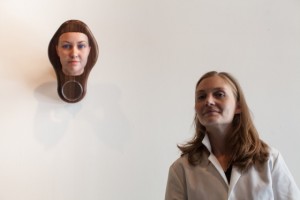[caption id="attachment_8999" align="alignright" width="300"]


Artist Heather Dewey-Hagborg has found a very interesting, and slightly creepy way to combine art and science with her new project, Stranger Visions. For the last year Dewey-Hagborg has created 3D sculptures based on found genetic materials. Her unique combination of informational/found art has been receiving accolades and earning her funding, but has also been raising awareness about the potential for genetic surveillance.
The Stranger Visions project all began a year ago when Dewey-Hagborg found herself one day staring at a stranger’s stray hair, and contemplating forensic science’s role in genetic surveillance. She decided to create 3D portraits based on genetic material from found objects. Most of us probably don’t think about all the genetic material we leave behind. The cigarette butts we leave in ashtrays, straws or water bottles in the trash can, the gum left under park benches; it all contains genetic information about who we are. Dewey-Hagborg immediately started collecting all these materials from public places. She then took it to a lab to analyze the DNA, and mine for any genetic info. The compiled data was loaded into a custom computer program that created a 3D model face based on all the genetic info available. The face was then printed out on a ZCorp 3D printer. The final product becomes a very realistic unattached face. The artist says it’s not an exact replica of the person, but more of a “family resemblance”.


Although these portraits are currently only a vague resemblance, the technology will continue to advance to a point where genetic tracking will eventually be a possibility. Not the most comforting thought for those who feel like true privacy is shrinking as fast as technology grows. It’s hard to predict how this technology will be used down the line, but thanks to Heather Dewey-Hagborg we will start asking some intriguing questions about the matter. At the very least, it will have us thinking about the cigarette butts and chewing gum we leave behind.

 Laptop & Tablet Parts
Laptop & Tablet Parts





















2 Responses to 3D printing people’s portraits with found DNA